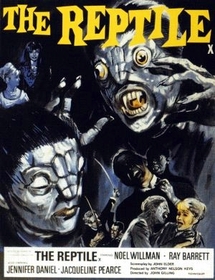Our editor-in-chief Nate Yapp is proud to have contributed to the new book Hidden Horror: A Celebration of 101 Underrated and Overlooked Fright Flicks, edited by Aaron Christensen. Another contributors include Anthony Timpone, B.J. Colangelo, Dave Alexander, Classic-Horror.com's own Robert C. Ring and John W. Bowen. Pick up a copy today from Amazon.com!
The Reptile (1966)
Filmed primarily on the same sets as one of Hammer's masterpieces, The Plague of the Zombies, by the same director, John Gilling, with some of the same cast--most notably the gorgeous Jacqueline Pearce (the equally beautiful Jennifer Daniel, a veteran from Hammer's Kiss of the Vampire, appears as well), and featuring a somewhat similar story, The Reptile, to its detriment, invites comparisons to Plague, a much superior film, and by contrast feels rushed and otherwise flawed.
The first problem comes in the way the story is relayed. Reptile is more committed to classification as a mystery, but the script by Anthony Hinds, a member of the Hammer royal family who was responsible for much of their best work, delivers its mystery elements by keeping the viewer in the dark for much of the film.
If it wasn't for the first wave credits at the beginning of the film, you'd likely think that you were watching the ending of Reptile instead--the opening plays like the culmination of a long story that you feel you should know something about. The staging, lighting and editing are sloppier here than Plague, and leave you even more confused about the opening, when a man suddenly tumbles down the stairs, dead.
Unlike Plague, your job during most of Reptile is to try to figure out just what the story might be about. Of course you have a hint given the title -- surely the film will hinge on reptiles, somehow. Unfortunately, Gilling doesn't do near as good a job here maintaining suspense, and the fact that you don't really know what is going on until almost the end robs the plot of much of the intrigue it might otherwise have.
Since I'm listing the faults first, I may as well cite two final problems. One is the score. Composer Don Banks' music, with one exception that I'll discuss below, is unfortunately some of his worst work and makes Reptile seem much more dated than most Hammer films. A majority of the score consists of overbearing noodling and melodramatic themes that announce "this is supposed to be music to a horror film" in a way that instead removes part of the horror element through its embrace of stereotype and cliche.
The second, and less serious one, is that Reptile, while not bland, exactly, is sadly missing the strength of the infamous "Hammer atmosphere." Creepiness almost rears its head a couple times, but it remains an underachiever.
So that's what's wrong with the film. There are positive aspects as well. First, I can't stress enough that Reptile fares worse by comparison to Plague, which I watched a few days beforehand. In isolation, while it would be far from perfect, I might grant it a bit more leniency, since I wouldn't realize how a superior handling of the sets and similar material might work.
The story, once you get a handle on it, is interesting enough, and I can easily see arguments that Gilling's point was to put viewers into the Spaldings' shoes. Harry Spalding is the brother of the man who dies in the opening, and he and his new wife settle into his brother's former cottage after the tragedy. Reptile is largely the story of the odd happenings in the Cornish village of Clagmoor as Harry and his wife try to solve a number of conundrums -- some of which would almost lead one to assume that everyone in the village in simply insane.
Speaking of which, Reptile contains some of Hammer's most straightforward instantiations of humor -- there are moments that could easily fit into a comedy, especially some of the scenes centering on the delightful character of Mad Peter. Although it's tough to top the performances of Plague, the acting in Reptile isn't below par by a long shot. The cast is smaller and the events may be less thrilling, but the troupe does their best with the material.
The sets and costumes are well-done, and although the cinematography isn't handled as well here, even though Arthur Grant is behind the lens again, it provides a very interesting lesson in how much difference framing, angles, lighting, and other technical elements can make.
The make-up effects are entertaining, although it is possible, if you're in the right mood, to mock them to an extent. The reptile itself appears to have fried eggs for eyes and as Fangoria's Dr. Cyclops noted in his review of the film, the victims look a bit like "Amos 'n' Andy with milk moustaches." Despite this, and although the film seemed to lack suspense in my eyes, as well, Reptile provoked one of the few times a film has made my wife scream in fear, so it must work for some people.
The backstory of the Franklyn's is very interesting and would have made a fine film itself. Anna's apparent obsession with Indian culture is one of the more intriguing elements of the film, and her sitar-playing is one of the better musical moments, and also provides Banks with the only motif (the Indian music is echoed in the score) that works.
While Reptile is certainly not near the top of Hammer's output, I must still recommend it, and not just because of the trivial relationship to Plague. A "bad" Hammer film is still better than a good portion of the genre as a whole. Don't attempt a viewing if you're not in the mood for a slower-moving film, but don't skip this one altogether, either.








